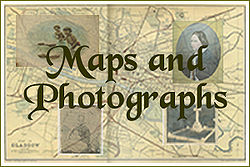Maps and Photography
Contents
Lloyd George's Domesday: a useful source c 1910
Valuation Office Records, popularly known as Lloyd George's Domesday are held at the National Archives.
This was a precursor of Capital Gains Tax. Tax would be paid on the increase in value of properties sold, so their values had to be calculated. Most were apparently done in the summer of 1914.
Every property in the country (well, England & Wales) was marked on a map, given a hereditament number and then the property described in a field book. The field books (in IR 58) each contain (up to) 100 properties and there are four standard preprinted pages for each property. You get owner, occupier, rental, a description of the property and value.
Not everything survives, of course, but where it does, you can find out if your ancestor was in a detached house or a terrace, what it was made of, who his or her neighbours were etc etc.
I've been to several talks, which all made research sound very complicated. The parish of Bury in Sussex stretches over 6 maps, so working from map to field book would be a long winded process, but there are only three field books (less than 300 properties) so you could go the other way round if looking for rural properties. The fieldbooks have references back to the maps, which are very large scale, often with coloured boundaries, so works of art.
It would be more difficult in a town, where you would have to be able to pinpoint a property on a map before you started, but townmaps are very large scale.
We may not have censuses available for the period yet, but for those who can get to the National Archives at Kew, this would certainly help our understanding of pre WW1 ancestors.
Map Links
- Aboutbritain is most useful for discovering the locality of Towns within every city in Britain, and their distances from one another. As well as providing other interesting information within those Towns and cities.
- Historic maps of London – most have indexes of place names
- Historic prints of London and other parts of Britain
- Lancashire County Council - Environment Directorate: Old Maps
- Historical map archive searchable by place name, address or coordinate (OS Grid Reference)
- Maps of Scotland 1560-1928
- Ponts Maps of Scotland
- Military Maps of Scotland (18th century)
- Ordnance Survey town plans 1847-1895
- Plans of Churches
- Norfolk Maps
- Archive maps London 1850 & 1860
- Archive maps london 1850 & 1860
Old London Maps
- Map of London in 1818 pre John Snow
- LONDON, WESTMINSTER AND SOUTHWARK BY JOHN ROCQUE 1746
- 1786 J Cary 15 Miles Round London
- 1819 Leigh's Environs of London
- 1827 Greenwood's Map of London
- 1859 John Snow's Map of London
- 1889 Charles Booth's Map of London Poverty
- London Maps - Various, from London Ancestor
- Another link to theCharles Booth map and pages from his book
Photograph Links
Photographs general
Place specific
Photographers
- Genealogy Photos Search for Volunteer Photographers.
Back to Main Page
